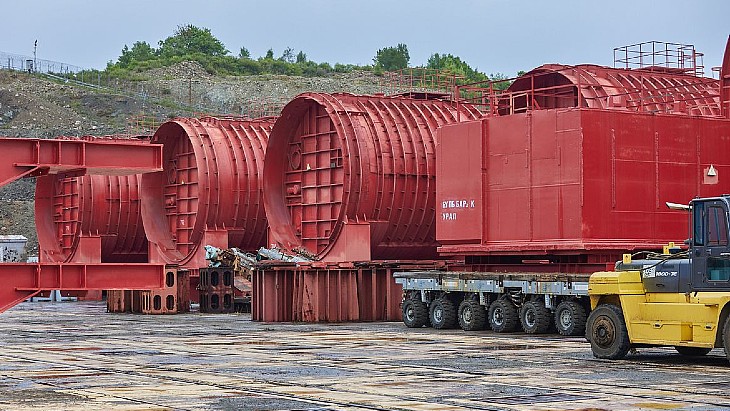Chernobyl confinement structure nears completion
 Installation of critical systems is progressing within the New Safe Confinement covering the damaged unit 4 of the Chernobyl nuclear power plant in Ukraine. The enormous arched structure was put in place one year ago and is expected to be commissioned in the first half of 2018.
Installation of critical systems is progressing within the New Safe Confinement covering the damaged unit 4 of the Chernobyl nuclear power plant in Ukraine. The enormous arched structure was put in place one year ago and is expected to be commissioned in the first half of 2018.Installation of critical systems is progressing within the New Safe Confinement (NSC) covering the damaged unit 4 of the Chernobyl nuclear power plant in Ukraine. The enormous arched structure was put in place one year ago and is expected to be commissioned in the first half of 2018.
.jpg) |
| The Chernobyl NSC (Image: EBRD) |
The NSC is the largest moveable land-based structure ever built, with a span of 257m, a length of 162m, a height of 108m and a total weight of 36,000 tonnes equipped. It will make the accident site safe and with a lifetime of 100 years will allow for the eventual dismantling of the ageing makeshift shelter from 1986 and the management of the radioactive waste. The NSC is designed to withstand temperatures ranging from -43°C to +45°C, a class-three tornado, and an earthquake with a magnitude of 6 on the Richter scale.
The process of sliding the arched structure from its assembly point into position over unit 4 was completed on 29 November 2016.
The European Bank for Reconstruction and Development (EBRD), which is managing funds for the project, said today: "Installation of critical cranage, ventilation and control systems is nearing completion and the final stages of sealing the confinement of the old structure is under way. Extensive testing is already under way before the structure will be commissioned and handed over to the management of the Chernobyl Nuclear Power Plant (ChNPP)."
Vince Novak, EBRD's nuclear safety director, said: "Strong progress has been made in difficult circumstances. The work on the end wall took place in an environment of heightened radiation and we are very proud that it was finished without any accidents or negative impact on the workforce. Meanwhile, the installation of the ventilation system and the high-tech crane create the preconditions for future decommissioning operations."
The end walls serve as a partition between the contaminated areas around unit and the remaining turbine hall. The walls - construction of which was completed by Ukrainian company PJSC Ukrenergomontazh in October 2016 - strengthen the existing facilities and seal the NSC from the environment, preventing the spread of radioactive materials to clean areas.
The NSC's ventilation system will ensure a relative humidity of no more than 40% to keep the metal structure free of corrosion. Pressure differentials will prevent the release of radioactive dust and other particles.
The technology building will serve as the command centre of the NSC from which day-to-day operations of the structure, as well as future decommissioning work, will be guided. A crucial role in this will fall to the fully-automated crane system, which has been installed within the arched structure. With a lifting capacity of up to 50 tonnes, the crane will allow for future dismantling of unit 4's reactor in a hermetically sealed environment.
The EBRD said testing and handovers of components and systems are in progress. The final handover to the ChNPP management is expected in the first half of 2018.
The NSC is being funded by the international community through donations to the EBRD. It is expected to cost EUR2.1 billion ($2.5 billion) and is funded by contributions from more than 40 countries and organisations. The EBRD said that to date it has provided EUR715 million of its own resources to support Chernobyl projects, including the NSC.
Novak noted, "While we are pleased with what has been achieved, more remains to be done and we are fully committed to finishing the job safely, to cost and on schedule."
Researched and written
by World Nuclear News
_17992.jpg)
_75800.jpg)







_88592.jpg)
_66488.jpg)

